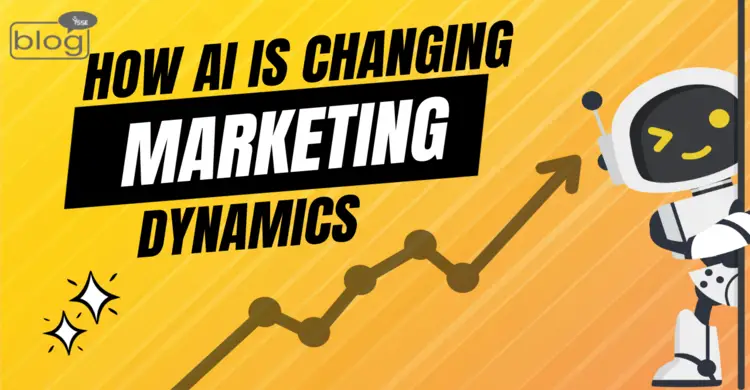Leave behind the old ways of marketing and welcome the age of marketing magic, where algorithms speak the language of customer preferences and AI changes the way marketing works.
We need to know what AI is before we move on. Artificial intelligence (AI) is the study of how machines, especially computers, can act intelligently. Machine learning and AI are both having a big impact on marketing and changing the way it works in many ways.
AI marketing combines customer and brand data to provide us a bird’s-eye view of our customer’s journey and market trends. NLP, ML, sentiment analysis, and other AI technologies can help us stay ahead of the competition and adapt to a changing market.
Making it possible for all customers to have personalised interactions
Nowadays, customers want a very detailed level of customization. A user’s location, hobbies, purchasing history, and encounters with the company in the past should all inform messages for marketing. Marketing teams may learn more about consumers’ tastes on a detailed, personalised level with the help of AI marketing, which goes beyond traditional demographic data. Brands can use this information to tailor their offerings to each customer’s individual preferences. Think about Netflix, which uses this information to give users personalised suggestions for pictures and TV shows based on what they like. We can take the example of Spotify as well.
Dynamic Forecaster: A Look Ahead at the Styles of Tomorrow
With the use of predictive analytics, we can take our voice of the customer data a step further, allowing us to plan forward based on prior results and anticipate outcomes. This opens up a world of possibilities for our company, including the ability to plan for the future, assess risks, enhance product designs, acquire new markets, and more. Take a look at Amazon, the biggest online store. AI makes personalised product ideas by looking at information about customers, what they do online, and what they buy. Not only can these personalised suggestions increase sales by 35%, but they also make shopping even better.
Getting along better with customers Making use of automation
Using linguistic and statistical triggers to drive intelligent workflows, AI-driven smart automation enables customer care teams and social media managers to boost operational efficiency. These virtual helpers (chatbots) know how to help customers in real-time, answer common questions, and walk them through the buying process. One example is that Marriott International’s website and mobile app now have a robot. Using artificial intelligence, this assistant replies right away to requests to make reservations. This speeds up the reservation process and makes customers happier in the end.
From Numbers to Stories
Natural Language Processing (NLP) tools that make writing sound natural have made it easier for marketers to make content that people will want to read. Your AI marketing tool’s ability to comprehend social listening data on a semantic and contextual level is made possible by natural language processing. By integrating statistical methods with rules-based lexical methods, it can scan a variety of posts, messages, reviews, or comments and extract important information from them. Let’s look at The Washington Post. It uses Heliograf, a platform for creating content driven by AI, to write news stories. This shows the promise of AI in content creation because it lets the news organisation quickly cover a lot of different topics.
Targeted ads that work
Our omnichannel business strategy can be guided by AI marketing, which uses market segmentation to target the customers most likely to purchase our product or service. Optimising digital ad selection and setup for maximum return on investment (ROI) may be a breeze with programmatic advertising. Because of this, more targeted advertising strategies may be developed to increase brand recognition and foster customer loyalty. Facebook uses AI algorithms to look at how users act, what they like, and how they connect. Advertisers can use this information to make exceptionally targeted ads that get their messages to the right people.
Automating tasks to save time and money
Marketing tasks that are boring but necessary, like writing on social media and running email campaigns, are much easier to handle when they are automated by AI. This saves time, makes sure communication is consistent across all media, and lowers the chance of mistakes. Marketers can focus on strategy while AI handles the execution. AI is used by LinkedIn to make job and content ideas automatically based on user profiles and interactions.
Learning about analytics and what it can do
Social listening data is categorised by prescriptive analytics according to customer motivations, mindsets, and intentions. By utilising the data provided by conversational analytics, we may create incredibly focused advertisements, social media postings, and email campaigns. The way streaming services remember our preferences and recommend shows and films that we might like is a perfect illustration of this. Google Analytics now gives us information that comes from machine learning, which goes beyond what traditional analytics can do. It can help marketers make choices about how to improve their campaigns based on data by letting them see patterns, outliers, and chances.
Every little step towards an AI-powered future, even if it’s just using a machine learning program to help write our email subject lines for our next digital marketing campaign, can help our brand surpass revenue goals all year long and stay ahead of the competition.
To read more blogs, click here
Writer, Tashfia Rashid
Intern, Content Writing Department
YSSE

